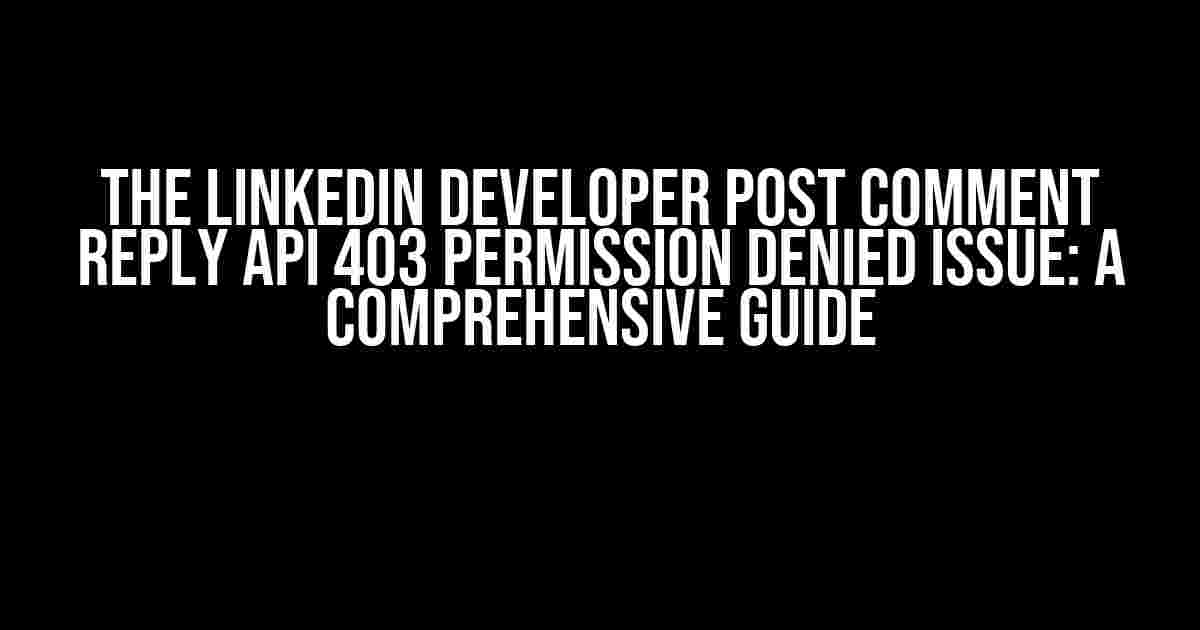Are you a developer trying to integrate the LinkedIn API into your application to enable users to comment and reply on posts? Have you encountered the frustrating 403 Permission Denied issue while trying to make API calls? You’re not alone! This article will guide you through the troubleshooting process and provide you with the necessary steps to resolve this issue once and for all.
Understanding the Error
The 403 Permission Denied error occurs when your application lacks the necessary permissions to perform a specific action on the LinkedIn platform. In the context of the comment reply API, this error can arise due to various reasons, including:
- Insufficient permissions
- Invalid API credentials
- Rate limiting
- LinkedIn’s security measures
Prerequisites
Before diving into the troubleshooting process, ensure you have the following:
- A LinkedIn Developer account
- A registered application with the necessary permissions (e.g., r_liteprofile, w_member_social)
- A valid access token with the required scopes (e.g., r_social, w_social)
- A basic understanding of the LinkedIn API and its endpoints
Step 1: Verify API Credentials and Permissions
Double-check your API credentials and ensure they are valid and correctly configured:
// Validate your client ID and client secret
const clientId = 'your_client_id';
const clientSecret = 'your_client_secret';
// Check if you have the necessary permissions
const permissions = ['r_liteprofile', 'w_member_social'];
Make sure you have the required permissions for the comment reply API. You can check the LinkedIn API documentation for more information on the necessary permissions.
Step 2: Inspect the Access Token
Verify that your access token has the required scopes:
// Get the access token
const accessToken = getAccessToken();
// Decode the access token
const tokenData = jwtDecode(accessToken);
// Check if the token has the necessary scopes
const hasRequiredScopes = tokenData.scope.includes('r_social') && tokenData.scope.includes('w_social');
if (!hasRequiredScopes) {
console.error('Access token lacks necessary scopes');
}
If your access token lacks the required scopes, regenerate a new token with the necessary permissions.
Step 3: Handle Rate Limiting
LinkedIn API has rate limits in place to prevent abuse. If you’re making excessive API calls, you might encounter the 403 error. To avoid this:
- Implement a caching mechanism to reduce the number of API calls
- Use the
x-li-page-sizeheader to limit the number of results per page - Implement a retry mechanism with exponential backoff to handle temporary rate limiting
Step 4: Validate the API Endpoint and Request
Verify that you’re using the correct API endpoint and request format:
// Verify the API endpoint
const endpoint = 'https://api.linkedin.com/v2/comments/(commentId)/replies';
// Validate the request headers
const headers = {
'Authorization': `Bearer ${accessToken}`,
'Content-Type': 'application/json',
};
// Check the request body
const requestBody = {
'comment': 'Your comment reply text',
};
Ensure you’re using the correct API endpoint and request format as specified in the LinkedIn API documentation.
Step 5: Check LinkedIn’s Security Measures
LinkedIn has security measures in place to prevent spam and abuse. If you’re making API calls from a server-side application, ensure:
- Your server’s IP address is whitelisted in the LinkedIn Developer Dashboard
- You’re not making API calls from a prohibited IP address
- You’re not using a prohibited user agent
Additional Troubleshooting Steps
If you’ve completed the above steps and still encounter the 403 error:
- Check the LinkedIn API status page for any outages or maintenance
- Verify that your application is registered in the LinkedIn Developer Dashboard
- Try making API calls with a different access token or from a different IP address
- Reach out to LinkedIn’s support team for assistance
Conclusion
The 403 Permission Denied issue can be frustrating, but by following these steps, you’ll be able to identify and resolve the underlying cause. Remember to carefully verify your API credentials, access token, and request format, and implement rate limiting and security measures to avoid common pitfalls. Happy coding!
| Error Code | Description | Solution |
|---|---|---|
| 403 | Permission Denied | Verify API credentials, access token, and request format. Implement rate limiting and security measures. |
By following this comprehensive guide, you’ll be able to overcome the 403 Permission Denied issue and successfully integrate the LinkedIn comment reply API into your application.
Frequently Asked Question
Stuck with the dreaded 403 permission denied issue while trying to reply to comments on a LinkedIn developer post? Don’t worry, we’ve got you covered! Here are some frequently asked questions to help you troubleshoot the problem.
Why am I getting a 403 permission denied error while trying to reply to a comment on a LinkedIn post?
This error occurs when your LinkedIn API credentials lack the necessary permissions to perform the action. Make sure you have the `r_comments` and `w_comments` permissions enabled for your API key. Also, ensure that the comment you’re trying to reply to is on a post that is publicly accessible.
I have the required permissions enabled, but I’m still getting the 403 error. What’s going on?
Check if the comment you’re trying to reply to is on a post that is part of a LinkedIn group. If so, you need to ensure that your API key has joined the group and has the necessary permissions to post comments.
How do I check if my API key has the necessary permissions?
Head over to the LinkedIn Developer Dashboard, navigate to your app’s settings, and click on “Auth” under the “Products” tab. There, you’ll see a list of permissions. Make sure `r_comments` and `w_comments` are enabled. If not, toggle them on and save your changes.
Can I use the LinkedIn API to reply to comments on behalf of another user?
No, the LinkedIn API does not support replying to comments on behalf of another user. You can only reply to comments as the authenticated user who authorized your API key.
What’s the rate limit for commenting and replying to comments on LinkedIn posts?
LinkedIn has a rate limit of 20 comments/replies per minute, per user. Be mindful of this limit to avoid getting flagged for abuse or having your API key revoked.





